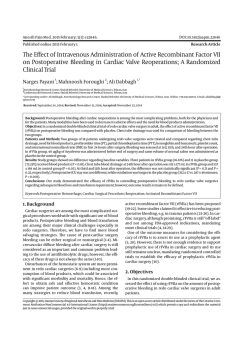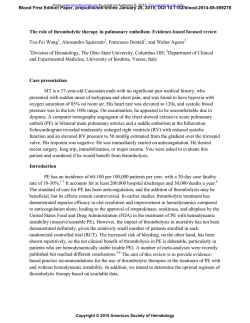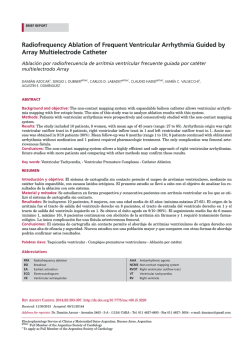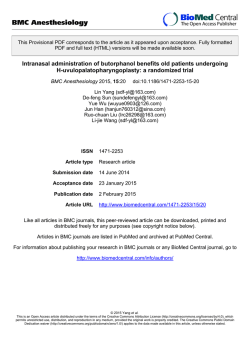
Boston Scientific: Home
482076 BosSci.qx7:15605. 7/29/08 8:27 PM Page 1 YOUR PERIOD doesn’t have to be a sentence. 482076 BosSci.qx7:15605. 7/29/08 8:27 PM Page 2 . . . . . What is endometrial ablation? Endometrial ablation is a procedure to treat abnormal uterine bleeding. The procedure is intended to destroy all or most of the tissue that is responsible for menstrual bleeding (the endometrium). After the procedure, you may never bleed again, or if you do, your bleeding should be reduced. Not all patients experience a satisfactory reduction in bleeding so all treatment options should be discussed with your doctor. . . . . . What is the Hydro ThermAblator®? The Hydro ThermAblator (HTA®) is a device that allows your gynecologist to perform endometrial ablation on an outpatient basis. This outpatient procedure allows your doctor to insert a probe into your uterus that includes a tiny telescope for viewing the lining of the uterus. Heated saline is circulated and is intended to destroy the lining of the uterus, even in an abnormal sized or shaped uterus, to eliminate or reduce bleeding to normal levels or less. 482076 BosSci.qx7:15605. 7/29/08 8:27 PM How does the HTA work? First, your cervix will be slightly dilated to allow the introduction of the telescope through the vagina, into the cervix and then into the uterus. This gives your gynecologist a view of the inside of your uterus to assure proper positioning. Then, your uterus will be filled with room temperature saline solution to gently clean and flush the uterus. The fluid will be heated to 90º C and circulated in the uterus for ten minutes in order to treat the endometrium (lining of the uterus). When the treatment is complete, the uterus will be flushed with room temperature saline to cool the uterus and the probe. All of the saline will be removed after the cooling phase is completed. Your uterine lining has been treated and will slough off similar to a menstrual period over the next few weeks. Page 3 482076 BosSci.qx7:15605. 7/29/08 8:27 PM Page 4 . . . . . How will I be evaluated to determine if endometrial ablation with the HTA is the right procedure for me? Your gynecologist will do some pretreatment tests that may include a Pap smear, an ultrasound, or a hysteroscopy (look inside the uterus with a tiny telescope) to see why you are having excessive menstrual bleeding. . . . . . Will I feel anything during the procedure? Your physician may give you pain medication before the procedure to minimize cramping during or after the procedure. You and your physician will decide what anesthesia will be best for you to receive during the procedure. Your options are to be fully asleep so you won’t feel anything during the procedure, or to receive some medication to be sedated (sleepy) during the procedure, or to receive only a local anesthesia injection and be fully awake. If you choose to be awake, you may feel some discomfort, such as mild cramping, during the procedure but it should not be painful. . . . . . What should I expect after my treatment? You should be able to return home on the day of your procedure. You may experience some light cramping that should go away by bedtime. Most women should be able to return to normal activities the next day. You will probably have a pink or yellow watery discharge for a few weeks after your treatment. If you experience two days of heavy bleeding, abdominal or pelvic pain, a fever, or pain that increases over time beyond 24 hours after the procedure, call your physician. 482076 BosSci.qx7:15605. 7/29/08 8:27 PM Page 5 . . . . . What should I expect after I go home? Most women should be able to return to normal daily activities the next day. You should speak with your physician about the resumption of sexual activity. Most patients experience a pink or yellow, watery discharge for a few weeks or longer after the procedure. You should not use tampons for up to seven days after the procedure to reduce the potential risk of infection. Your monthly menstrual bleeding may be heavy for a few months after the treatment as a part of the healing process, and should improve after a few months. . . . . . Can I get pregnant after treatment with HTA? You should not have this procedure if you desire pregnancy in the future. Endometrial ablation, however, does not prevent you from becoming pregnant and such a pregnancy would be high risk for both mother and fetus. Contraception or sterilization should be used after this treatment since pregnancy can still occur. Please discuss the different options with your physician. . . . . . What are the risks of treatment with the HTA? Treatment with the HTA may involve some rare but potential risks that include perforation (creation of a hole) in the wall of the uterus, a hot fluid bowel or other internal organ burn or leakage of hot fluid into the cervix or vagina. Collection of blood and/or tissue in the uterus post procedure (hematometra) may occur and may require another outpatient procedure to correct the problem. 482076 BosSci.qx7:15605. 7/29/08 8:27 PM Page 6 What other treatments are available to treat excessive menstrual bleeding? Medication – Hormonal therapy, sometimes as simple as birth control pills, may be prescribed for women who experience heavy menstrual bleeding due to a hormonal imbalance and who wish to preserve their fertility after treatment. Dilation and Curettage (D&C) – This surgical procedure may provide a temporary solution to heavy menstrual bleeding. The top layer of the lining of the uterus (the endometrium) is scraped away, often under general anesthesia in an outpatient setting. Risks include perforation of the wall of the uterus, injury to the bowel or other internal organs, bleeding, or infection. A D&C provides a tissue sample to help your doctor determine the cause of excessive bleeding and to rule out any abnormalities. ENDOMETRIAL ABLATION Balloon therapy – This outpatient procedure allows your doctor to insert a probe with a balloon into your uterus that will allow the lining of your uterus to be heated with hot fluid to reduce excessive menstrual bleeding. This treatment is most successful when the shape and size of the uterus are normal. Risks include perforation of the wall of the uterus and possible injury to the bowel or other internal organs. Hysteroscopic Endometrial Ablation – This procedure involves the use of a surgical instrument that gives the doctor a view of the inside of your uterus. This instrument allows the doctor to remove all or the majority of the endometrial lining using electrosurgery or a laser. This surgical procedure is often performed under general anesthesia and is intended to eliminate or reduce bleeding to normal levels or less. The recovery 482076 BosSci.qx7:15605. 7/29/08 8:27 PM Page 7 from endometrial ablation is much shorter and generally less painful than a hysterectomy. Hysterectomy – The complete surgical removal of the uterus provides a final cure for excessive menstrual bleeding. The procedure is considered major surgery and is performed under general anesthesia. A hospital stay is generally required and recovery may take several weeks. Hysterectomy may be performed when other forms of therapy have failed or are not an option. ® HTA Therapy The new choice for excessive menstrual bleeding. If you feel controlled by heavy bleeding during your periods and believe your options are to wait until menopause or to have a hysterectomy, there may be another choice for help without major surgery. A new, minimally invasive choice is available for your consideration for the treatment of excessive menstrual bleeding; the Hydro ThermAblator (HTA) has the potential to offer: • An alternative to hysterectomy or other major surgical procedures • An outpatient procedure • Decreased recovery period and less need for general anesthesia • Fewer significant harmful side effects Speak with your doctor if you have questions about the HTA and to understand this new treatment for excessive menstrual bleeding. 482076 BosSci.qx7:15605. 7/29/08 8:27 PM Page 8 Refer to HTA® System Installation and Operator’s Manual provided with product for complete instructions for use. INDICATIONS: The Hydro ThermAblator® (HTA) System is a hysteroscopic thermal ablation device intended to ablate the endometrial lining of the uterus in premenopausal women with menorrhagia (excessive uterine bleeding) due to benign causes for whom childbearing is complete. CONTRAINDICATIONS: The HTA System is contraindicated for use in a patient: who is pregnant or wants to be pregnant in the future, as pregnancy after ablation can be dangerous to both mother and fetus; who has known or suspected endometrial carcinoma or premalignant change of the endometrium, such as adenomatous hyperplasia; who has active pelvic inflammatory disease or pyosalpinx; hydrosalpinx; who has any anatomical or pathologic condition in which weakness of the myometrium could exist, such as, prior classic cesarean section or transmural myomectomy; who has an intrauterine device in place; or who has active genital or urinary tract infection, e.g., cervicitis, endometritis, vaginitis, cystitis, etc., at the time of treatment. POTENTIAL ADVERSE EFFECTS that may occur include: thermal injury to adjacent tissue including cervix, vagina, vulva, and/or perineum; heated saline escaping from the device system into the vascular spaces; hemorrhage; perforation of uterus; complications with pregnancy (Note: pregnancy following ablation is dangerous to both the mother and the fetus); risks associated with hysteroscopy. WARNINGS: NOTE: Failure to follow any instructions or to heed any Warnings or Precautions could result in serious patient injury. CAUTION: Federal Law restricts this device to sale by or on the order of a physician. The physician using the device must be trained in diagnostic hysteroscopy. Boston Scientific Corporation One Boston Scientific Place Natick, MA 01760-1537 www.bostonscientific.com/gynecology Ordering Information 1.888.272.1001 © 2008 Boston Scientific Corporation or its affiliates. All rights reserved. MVU1470 20M 6/08
© Copyright 2025
![Program - divine [id]](http://s2.esdocs.com/store/data/000470652_1-6d8f29df4fa45e08df5ac6fab3afd084-250x500.png)
![Download [ PDF ] - journal of evidence based medicine and](http://s2.esdocs.com/store/data/000499809_1-c6b1e3dfacc473ca04f6534c5a5c7150-250x500.png)








